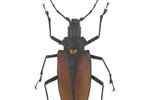
Onions (Allium spp.), native to Asia and the Mediterranean, are a staple in kitchens around the world. Humans aren't the only creatures that enjoy onions. While onions and all Allium genus plants are toxic to dogs (Canis spp.) and cats (Felis spp.), four bugs are known to infest onions in the garden and in storage.
Bulb Mites
Bulb mites infest a number of bulbs, including crocus, freesias, lilies, narcissus, tulips, garlic and onions. These tiny, yellowish-white or pinkish arachnids (Rhizoglyphus spp. and Tyrophagus spp.) are only 0.5 to 1.0 millimeter long and resemble little oval balls with four pairs of short, brown legs. Bulb mites are short-lived, with the female dying in a month and the males shortly after mating, but they can nonetheless quickly infest bulbs in the field or in storage. The mites prefer temperatures between 60 and 80 degrees Fahrenheit. Although predatory mites (Hypoaspis aculeife) are available for pest control, eliminating bulb mites from the garden is difficult.
Nematodes
A variety of nematodes, including lesion nematodes (Pratylenchus penetrans), root knot nematodes (Meloidogyne spp.), stem and bulb nematodes (Ditylenchus dipsaci) and stubby root nematode (Paratrichodorus spp.) infest onions. Nematodes are microscopic roundworms that feed on plants. They live in the soil and inside the plants, feeding on the roots, stems and bulbs. Once the nematodes have pierced the onion's skin, other soil-borne pathogens and fungi can enter the bulb, causing it to rot from the inside out.
Onion Maggots
Onion maggots (Delia antiqua) and their close relatives, seed corn maggots (Delia platura), are the larvae of small gray flies. They infest corn and onion plants. The larvae hatch from eggs laid near the developing seedlings, preferring non-decomposed organic matter in the soil. Both of the 0.4-inch-long maggots feed on the roots and developing seedlings; onion maggots also infest the growing bulbs. The maggots also attack broccoli, cabbage and cauliflower. Onion maggot predators include ground beetles (Carabidae family) and parasitic nematodes (Steinernema spp.).
Wheat Curl Mites
The tiny wheat curl mites (Eriophyes tulipae) feed on onions, usually after they've been placed in storage. The 0.01-inch mites also feed on tulip bulbs, garlic bulbs, corn, wheat, wild grasses and a variety of grains. In the field, the mites infest the foliage before working their way down into the developing bulbs. When infesting onion bulbs, the mites cause bulbs to dry out or rot. In addition to feeding on onions and other bulbs, the mites also carry several mosaic viruses that affect grain crops such as corn and wheat.
References
- Texas A&M AgriLife Extension: Onions and Other Pungent Lilies
- Veterinary Pet Insurance: Pets and Onions -- Each Layer Can Poison Your Pets
- UC IPM Online: Onion and Garlic -- Bulb Mites
- UMassAmherst Greenhouse Crops and Floriculture Program: Bulb Mites
- UC IPM Online: Onion and Garlic -- Nematodes
- UC IPM Online: Onion and Garlic -- Maggots
- UMassAmherst Agriculture & Landscape Program: Vegetable Program -- Onion Maggot
- UC IPM Online: Onion and Garlic -- Wheat Curl Mite
- Mites Injurious to Economic Plants; L.R. Jeppson, et al.
- The National Onion Association: History of Onions
Photo Credits
-
Ryan McVay/Photodisc/Getty Images
Writer Bio
With degrees in fine and commercial art and Spanish, Ruth de Jauregui is an old-school graphic artist, book designer and published author. De Jauregui authored 50 Fabulous Tomatoes for Your Garden, available as an ebook. She enthusiastically pursues creative and community interests, including gardening, home improvement and social issues.




